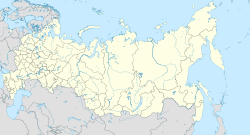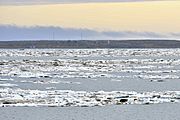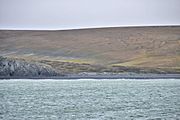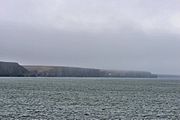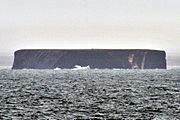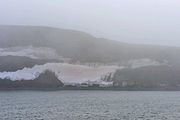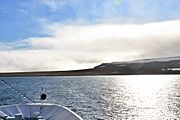New Siberian Islands facts for kids
|
Native name:
|
|
|---|---|
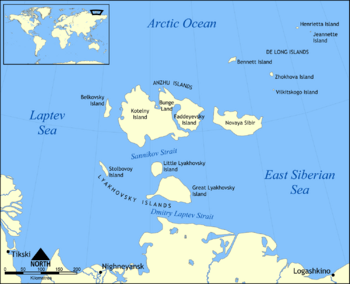
Location of the New Siberian Islands
|
|
|
New Siberian Islands (Russia)
|
|
| Geography | |
| Location | between the Laptev Sea and East Siberian Sea |
| Coordinates | 75°16′N 145°15′E / 75.267°N 145.250°E |
| Archipelago | New Siberian Islands |
| Area | 29,900 km2 (11,500 sq mi) |
| Highest elevation | 374 m (1,227 ft) |
| Highest point | Malakatyn Tas |
| Administration | |
| Federal subject | Sakha Republic |
| Demographics | |
| Population | 2 (2017) on Kotelny Island |
The New Siberian Islands (in Russian: Новосиби́рские Oстрова; in Yakut: Саҥа Сибиир Aрыылара) are a group of islands in the far north of Russia. They are located between two large seas, the Laptev Sea and the East Siberian Sea. These islands are part of the Sakha Republic (also known as Yakutia).
Contents
Exploring the New Siberian Islands: A Look at Their History
The first people to learn about the New Siberian Islands were Cossacks in the early 1700s. A Cossack named Yakov Permyakov shared the news. In 1712, a group of Cossacks led by M. Vagin reached Great Lyakhovsky Island.
Later, in 1809–1810, explorers Yakov Sannikov and Matvei Gedenschtrom went on a mapping trip to these islands. Sannikov claimed he saw a "new land" north of Kotelny Island in 1811. This led to the legend of Sannikov Land, a mysterious land that many believed existed but was never truly found.
In 1886, a polar explorer named Eduard von Toll also thought he saw an unknown land north of Kotelny Island. He believed it might be the famous Zemlya Sannikova.
Toll visited the islands again in 1892. He traveled by dog sled across the ice to the south coast of Great Lyakhovsky Island. There, he found amazing things like well-preserved bones, fossil ivory, and even a tree. These items were found in tall sea cliffs, showing how the land has changed over thousands of years.
More recently, in September 2014, the Russian Navy reopened a naval base on Kotelny Island. This base had been closed since 1993.
Discovering the Geography of the New Siberian Islands
The New Siberian Islands are divided into a few main groups. The largest group is called the Anzhu Islands. They cover an area of about 29,000 square kilometers (about 11,197 square miles).
Here are some of the main islands in the Anzhu group:
- Kotelny Island: This is a large island, about 11,700 square kilometers (4,517 sq mi).
- Faddeyevsky Island: This island is about 5,300 square kilometers (2,046 sq mi).
- Bunge Land: This area is about 6,200 square kilometers (2,394 sq mi). It often gets covered by the sea. It connects Kotelny Island and Faddeyevsky Island.
- Novaya Sibir: This island is about 6,200 square kilometers (2,394 sq mi).
- Belkovsky Island: This island is smaller, about 500 square kilometers (193 sq mi).
South of the Anzhu Islands, closer to the mainland, are the Lyakhovskiye Islands. They cover about 6,095 square kilometers (2,353 sq mi).
- Great Lyakhovsky Island: This is the largest in this group, about 4,600 square kilometers (1,776 sq mi).
- Little Lyakhovsky Island: This island is about 1,325 square kilometers (512 sq mi).
- Stolbovoy Island: This island is about 170 square kilometers (66 sq mi).
- Semyonovsky Island: This island used to exist but is now completely underwater.
Even further northeast of Novaya Sibir are the small De Long Islands.
- Jeannette Island
- Henrietta Island
- Bennett Island
- Vilkitsky Island
- Zhokhov Island
The New Siberian Islands are mostly flat and low-lying. The highest point is on Bennett Island, which is 426 meters (1,398 feet) high. These islands are part of a larger flat area called the East Siberian Lowland.
Thousands of years ago, during the last Ice Age, these islands were part of a huge plain called the Great Arctic Plain. This plain connected Siberia and Alaska. The sea level was much lower then, and most of this plain is now underwater. The islands we see today are just the highest parts of that ancient land.
Uncovering the Geology of the New Siberian Islands
The New Siberian Islands are made up of many different types of rocks. These rocks range from very old (Precambrian) to more recent (Pliocene). They include sedimentary rocks, which are formed from layers of sediment, and igneous rocks, which are formed from cooled lava or magma.
For example, the Lyakhovsky Islands have ancient metamorphic rocks (rocks changed by heat and pressure). They also have layers of sandstone and shale from different time periods. The Anzhu Islands have limestone and dolomite (types of rock often found in oceans), along with other sedimentary and igneous rocks. The De Long Islands are mostly made of basalt, a common volcanic rock.
These older rocks are covered by a layer of loose sediments from the Pleistocene and Holocene periods. This top layer can be from less than a meter to about 35 meters (115 feet) thick.
Some old stories about the New Siberian Islands said they were made almost entirely of mammoth bones and tusks, or just ice and sand with bones. However, scientists who have studied the islands closely have shown that these stories are not true. While there are many bones, the islands are made of various rocks and sediments, not just bones.
Amazing Ivory Deposits: A Treasure from the Past
One of the most interesting things about the New Siberian Islands is the huge amount of fossil ivory found there. This ivory comes from mammoths and other ancient animals. It is found on beaches, in riverbeds, and along riverbanks. The ivory from these islands is so well-preserved that it looks almost like fresh ivory.
The many bones and even full skeletons of mammoths, rhinoceroses, and musk-oxen are kept safe by permafrost. Permafrost is ground that stays frozen all year round. As layers of soil and sediment built up over thousands of years, the permafrost froze around these animal remains, preserving them.
Scientists have used special dating methods to figure out how old these bones and ivory are. They found that the remains accumulated over about 200,000 years. Some mammoth tusks and bones found on Kotelny and New Siberia islands are over 50,000 years old!
Understanding the Climate of the New Siberian Islands
The climate on the New Siberian Islands is arctic and very harsh. Snow covers the ground for about nine months of the year.
- Winter Temperatures: In January, the average temperature is extremely cold, ranging from about -28°C to -31°C (-18°F to -24°F).
- Summer Temperatures: In July, the coasts stay cool because of the icy Arctic water. Average high temperatures are around +8°C to +11°C (46°F to 52°F). However, in the middle of the islands, it can get warmer, with average high temperatures reaching +16°C to +19°C (61°F to 66°F).
- Rain and Snow: The islands don't get much precipitation, only up to 132 mm (about 5 inches) a year.
Permafrost (permanently frozen ground) and underground ice are very common here. The surface of the islands is covered with tundra plants and many lakes.
The ocean around the islands is frozen for most of the year. In warmer years, ships can sail through the ice from July to October. But in colder years, the islands might stay surrounded by ice all summer.
During the winter, from November to February, the islands experience polar night. This means the sun does not rise at all. In contrast, during the summer months, the sun stays above the horizon all day and night.
| Climate data for Kotelny Island | |||||||||||||
|---|---|---|---|---|---|---|---|---|---|---|---|---|---|
| Month | Jan | Feb | Mar | Apr | May | Jun | Jul | Aug | Sep | Oct | Nov | Dec | Year |
| Record high °C (°F) | −7.2 (19.0) |
−3.3 (26.1) |
−4.8 (23.4) |
0.3 (32.5) |
6.2 (43.2) |
22.7 (72.9) |
25.1 (77.2) |
20.2 (68.4) |
11.8 (53.2) |
1.8 (35.2) |
−2.5 (27.5) |
−3.1 (26.4) |
25.1 (77.2) |
| Mean daily maximum °C (°F) | −26.1 (−15.0) |
−26.4 (−15.5) |
−24.2 (−11.6) |
−16.9 (1.6) |
−6.2 (20.8) |
1.4 (34.5) |
5.7 (42.3) |
4.3 (39.7) |
0.3 (32.5) |
−8.1 (17.4) |
−18.2 (−0.8) |
−23.8 (−10.8) |
−11.5 (11.3) |
| Daily mean °C (°F) | −29.3 (−20.7) |
−29.7 (−21.5) |
−27.5 (−17.5) |
−20.3 (−4.5) |
−8.6 (16.5) |
−0.4 (31.3) |
2.9 (37.2) |
2.1 (35.8) |
−1.2 (29.8) |
−10.7 (12.7) |
−21.5 (−6.7) |
−27.0 (−16.6) |
−14.3 (6.3) |
| Mean daily minimum °C (°F) | −32.6 (−26.7) |
−32.9 (−27.2) |
−30.9 (−23.6) |
−24.2 (−11.6) |
−11.4 (11.5) |
−2.1 (28.2) |
0.6 (33.1) |
0.2 (32.4) |
−3.0 (26.6) |
−13.7 (7.3) |
−24.8 (−12.6) |
−30.3 (−22.5) |
−17.1 (1.2) |
| Record low °C (°F) | −44.9 (−48.8) |
−49.9 (−57.8) |
−46.1 (−51.0) |
−46.2 (−51.2) |
−28.6 (−19.5) |
−14.9 (5.2) |
−6.0 (21.2) |
−9.2 (15.4) |
−18.6 (−1.5) |
−40.2 (−40.4) |
−40.2 (−40.4) |
−45.0 (−49.0) |
−49.9 (−57.8) |
| Average precipitation mm (inches) | 7 (0.3) |
5 (0.2) |
6 (0.2) |
8 (0.3) |
9 (0.4) |
17 (0.7) |
26 (1.0) |
23 (0.9) |
23 (0.9) |
16 (0.6) |
7 (0.3) |
7 (0.3) |
154 (6.1) |
| Average rainy days | 0 | 0 | 0 | 0.1 | 1 | 8 | 15 | 15 | 9 | 0.4 | 0 | 0 | 49 |
| Average snowy days | 15 | 16 | 16 | 15 | 22 | 16 | 8 | 11 | 22 | 26 | 18 | 16 | 201 |
| Average relative humidity (%) | 82 | 82 | 82 | 83 | 87 | 90 | 90 | 91 | 90 | 88 | 84 | 82 | 86 |
| Mean monthly sunshine hours | 0 | 7 | 147 | 283 | 197 | 178 | 168 | 100 | 44 | 14 | 0 | 0 | 1,138 |
| Source 1: Pogoda.ru.net | |||||||||||||
| Source 2: NOAA (sun 1961–1990) | |||||||||||||
Photo gallery
See also
 In Spanish: Islas de Nueva Siberia para niños
In Spanish: Islas de Nueva Siberia para niños


